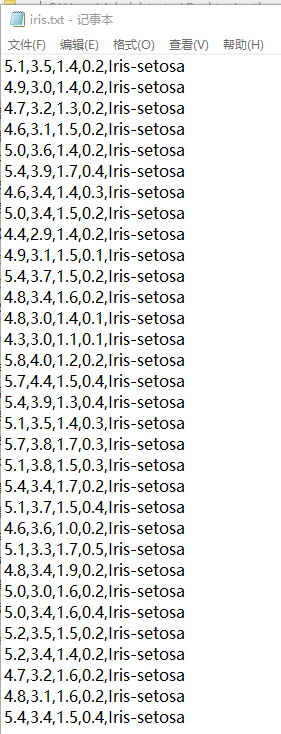python——KNN
实例:
| 电影名称 | 打斗次数 | 接吻次数 | 电影类型 |
| California Man | 3 | 104 | Romance |
| He's Not Really into Dudes | 2 | 100 | Romance |
| Beautiful Woman | 1 | 81 | Romance |
| Kevin Longblade | 101 | 10 | Action |
| Robot Slayer 3000 | 99 | 5 | Action |
| Amped II | 98 | 2 | Action |
| 未知 | 18 | 90 | Unknown |
题目:根据前几个电影的数据,预测未知电影的类型。
关于衡量距离的方法:
未知电影到底属于哪种类型,就需要计算G点到A、B、C、D、E、F点的距离
| 点 | X坐标 | Y坐标 | 点类型 |
| A点 | 3 | 104 | Romance |
| B点 | 2 | 100 | Romance |
| C点 | 1 | 81 | Romance |
| D点 | 101 | 10 | Action |
| E点 | 99 | 5 | Action |
| F点 | 98 | 2 | Action |
| G点 | 18 | 90 | Unknown |
例如计算A和G之间的距离:
import math
def ComputeEuclidearDistance(x1,y1,x2,y2):
d = math.sqrt(math.pow((x1 - x2), 2) + math.pow((y1 - y2), 2)) #距离公式
return d
d_ag = ComputeEuclidearDistance(3, 104, 18, 90) #A和G之间的距离
d_bg = ComputeEuclidearDistance(2, 100, 18, 90) #B和G之间的距离
d_cg = ComputeEuclidearDistance(1, 81, 18, 90) #C和G之间的距离
d_dg = ComputeEuclidearDistance(101, 10, 18, 90) #D和G之间的距离
d_eg = ComputeEuclidearDistance(99, 5, 18, 90) #E和G之间的距离
d_fg = ComputeEuclidearDistance(98, 2, 18, 90) #F和G之间的距离
print(d_ag, '\n', d_bg, '\n', d_cg, '\n', d_dg, '\n', d_eg, '\n', d_fg)结果为:
20.518284528683193
18.867962264113206
19.235384061671343
115.27792503337315
117.41379816699569
118.92854997854805
此时选取3(K值)个距离最小的值,就是A、B、C,而A、B、C都是Romance,所以G属于Romance类型,若A、B、C类型不同,则按少数服从多数的原则来判别。
算法优点:简单、易于理解,容易实现、通过K的选择课具备丢噪音数据的健壮性
缺点:计算复杂度高、所需存储空间大,当样本分布不平衡时,预测结果不准
改进:距离上加权重(1/d,d为距离)
用KNN预测鸢尾花的类别:
from sklearn import neighbors
from sklearn import datasets
knn = neighbors.KNeighborsClassifier() #导入knn分类器
iris = datasets.load_iris()
#加载数据,数据是字典{'data':array(150,4),'target': array(150,1),'target_names': array(3,1)}
# 共3类(iris-setosa, iris-versicolour, iris-virginica)
# 150个花,每个花包含(花萼长度、花萼宽度、花瓣长度、花瓣宽度)4个属性
print(iris)
knn.fit(iris.data,iris.target)
predictedlabel = knn.predict([[0.1, 0.2, 0.3, 0.4]]) #预测参数为[0.1, 0.2, 0.3, 0.4]的花的类别
print(predictedlabel)结果为 0,即属于第一种
自己编写KNN识别鸢尾花:
此处要用到鸢尾花的数据,将其转化为txt格式(单独的txt文件下载地址:https://download.csdn.net/download/qq_42006303/11523094)
格式如图所示:
代码:
import csv
import random
import math
import operator
# from sklearn import datasets
def LoadDataset(filename, split, trainingSet = [], testSet = []): #加载数据
#split将数据集分为训练集和测试集
with open(filename,"rt", encoding="utf-8") as csvfile:
lines = csv.reader(csvfile) #读行
dataset = list(lines) #将其按行转化为列表
# print('dataset',dataset)
# print(len(dataset))
for x in range(len(dataset) - 1): #len(dataset)=150
for y in range(4):
dataset[x][y] = float(dataset[x][y]) # float() 函数用于将dataset中的整数和字符串转换成浮点数
if random.random() < split: #random.random()随机产生一个[0,1)之间的数(共产生150个),小于split的是训练集否则是测试集,此处split=0.67
trainingSet.append(dataset[x])
# print(random.random())
else:
testSet.append(dataset[x])
def euclideanDistance(instance1, instance2, length): #计算距离,所有维度,instance1, instance2分别代表两个样本的参数
distance = 0
for x in range(length):
distance += pow((instance1[x] - instance2[x]), 2) #所有对应参数差的平方之和,共有length=4组参数
return math.sqrt(distance) #开二次方,计算距离
def getNeighbors(trainingSet, testInstance, k): #返回最近的K个邻居
distances = []
length = len(testInstance) - 1
# print('length',length)
for x in range(len(trainingSet)):
dist = euclideanDistance(testInstance, trainingSet[x], length) #计算测试数据和所有训练数据距离
distances.append((trainingSet[x], dist)) #将计算的距离依次写入distances
distances.sort(key=operator.itemgetter(1)) #距离由小到大排序
# print(distances)
neighbors = []
for x in range(k):
neighbors.append(distances[x][0]) #取距离最小的前三个作为邻居
# print(neighbors)
return neighbors
def getResponse(neighbors): #根据少数服从多数预测数据归于哪一类
classVotes = {}
for x in range(len(neighbors)):
response = neighbors[x][-1] #统计邻居中的标签
# print(response)
if response in classVotes:
classVotes[response] += 1 #若某邻居标签在classVotes中,该标签个数加1
else:
classVotes[response] = 1 #若某邻居标签不在classVotes中,该标签个数为1
sorteVotes = sorted(classVotes.items(), key=operator.itemgetter(1), reverse=True) #对classVotes中的key按降序排列
return sorteVotes[0][0] #返回标签
def getAccuracy(testSet, predictions): #计算准确率
correct = 0
for x in range(len(testSet)):
if testSet[x][-1] == predictions[x]: #若预测值和真实值相同则correct加1
correct += 1
return (correct/float(len(testSet))) * 100.0 #转化为百分数
def main():
trainingSet=[]
testSet=[]
split = 0.67
LoadDataset(r'./iris.txt', split, trainingSet, testSet) #加载数据,并分为训练集和测试集
print('Train set:' + repr(len(trainingSet)))
print('Test set:' + repr(len(testSet)))
predictions=[]
k=3 #3个邻居
for x in range(len(testSet)):
neighbors = getNeighbors(trainingSet, testSet[x], k)
result = getResponse(neighbors)
predictions.append(result)
print('>predicted='+repr(result)+', actual='+repr(testSet[x][-1]))
accuracy = getAccuracy(testSet, predictions)
print('Accuracy:'+repr(accuracy)+'%')
if __name__ == '__main__':
main()
完整程序和数据集:https://download.csdn.net/download/qq_42006303/11523096
